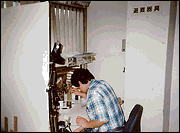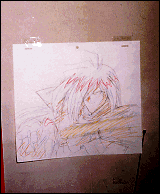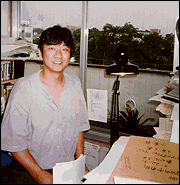
 Painting a cel is a difficult task, requiring concentration and a steady hand.  Animators often place favorite pieces of their work on the wall for both inspirational and aesthetic reasons. |

(continued from previous page)
Downstairs is the animation studio. The animators were involved in their
work, and most of them hardly took any notice of us as we peered over their
shoulders, took a picture or two, and talked loudly in English behind them.
It is interesting to see exactly how independently these people work. While
they all work in the same room, each has his or her own cubicle loaded with
personal items, as well as reference materials. UFO catcher dolls abound,
and images of favorite shows and characters line the cubicles, covering
almost every square inch of space. Every animator also had a personal CD
player and a large stack of CDs.
![]() In the paint
studio, I saw two women conversing on how to paint a cel. I
thought this was a bit unusual, since most of the staff I had seen thus far
seemed to work independently when it came to cel painting. Scott explained
that one of the women was a new employee who was being trained in cel
painting. For a little while, she would have someone who would be helping
her with her work until she got the hang of it and could go it alone.
In the paint
studio, I saw two women conversing on how to paint a cel. I
thought this was a bit unusual, since most of the staff I had seen thus far
seemed to work independently when it came to cel painting. Scott explained
that one of the women was a new employee who was being trained in cel
painting. For a little while, she would have someone who would be helping
her with her work until she got the hang of it and could go it alone.
![]() Scott also
showed us the paint cabinet and explained a little about cel
paint. There are approximately 350 colors used in typical Japanese
animation production, which is much more than the standard number used in
the United States. Of these 350 colors, a television series/OVA series will
normally use approximately 80 to 120 colors, while a feature film will use
many more. Cel paint is expensive and prone to molding in the summer and
rainy season, so oftentimes a limited supply is kept on hand. "The rainy
season is the ultimate nightmare for paint," Scott adds.
Scott also
showed us the paint cabinet and explained a little about cel
paint. There are approximately 350 colors used in typical Japanese
animation production, which is much more than the standard number used in
the United States. Of these 350 colors, a television series/OVA series will
normally use approximately 80 to 120 colors, while a feature film will use
many more. Cel paint is expensive and prone to molding in the summer and
rainy season, so oftentimes a limited supply is kept on hand. "The rainy
season is the ultimate nightmare for paint," Scott adds.
![]() We were
also very fortunate to be allowed into Ogura Studios. Mr. Ogura
Hiromasa is one of the most prominent Art Directors in the world. He talked
with us for several minutes and allowed us to annoy his staff as we looked
around his studio and told us that fame comes with a price. He often
receives phone calls and requests for consulting on various projects.
Sometimes, in fact, he says he is so busy taking phone calls that he can't
get anything done. But obviously, he does, as his work on
GHOST IN
THE SHELL
and the PATLABOR movies proves.
We were
also very fortunate to be allowed into Ogura Studios. Mr. Ogura
Hiromasa is one of the most prominent Art Directors in the world. He talked
with us for several minutes and allowed us to annoy his staff as we looked
around his studio and told us that fame comes with a price. He often
receives phone calls and requests for consulting on various projects.
Sometimes, in fact, he says he is so busy taking phone calls that he can't
get anything done. But obviously, he does, as his work on
GHOST IN
THE SHELL
and the PATLABOR movies proves.
![]() Our next
stop was an empty feature film key animators studio. Scott
explained that animators sometimes keep very long hours, working late into
the night. As a result, they often come in late in the afternoon. In fact,
there was only one person in the studio at the time; that person was Mr.
Oshii Mamoru, director of such blockbusters as GHOST
IN THE
SHELL and the PATLABOR
films. He welcomed us to I.G and told us that he liked
to come in early because "no one else is around and I can get a lot of work
done." At the time, he was working on his next project, a pilot for another
feature film.
Our next
stop was an empty feature film key animators studio. Scott
explained that animators sometimes keep very long hours, working late into
the night. As a result, they often come in late in the afternoon. In fact,
there was only one person in the studio at the time; that person was Mr.
Oshii Mamoru, director of such blockbusters as GHOST
IN THE
SHELL and the PATLABOR
films. He welcomed us to I.G and told us that he liked
to come in early because "no one else is around and I can get a lot of work
done." At the time, he was working on his next project, a pilot for another
feature film.
 Mr. Ogura takes a brief respite from his hectic schedule and smiles for the camera in his office.  One of Mr. Ogura's employees puts some finishing touches on a background. |